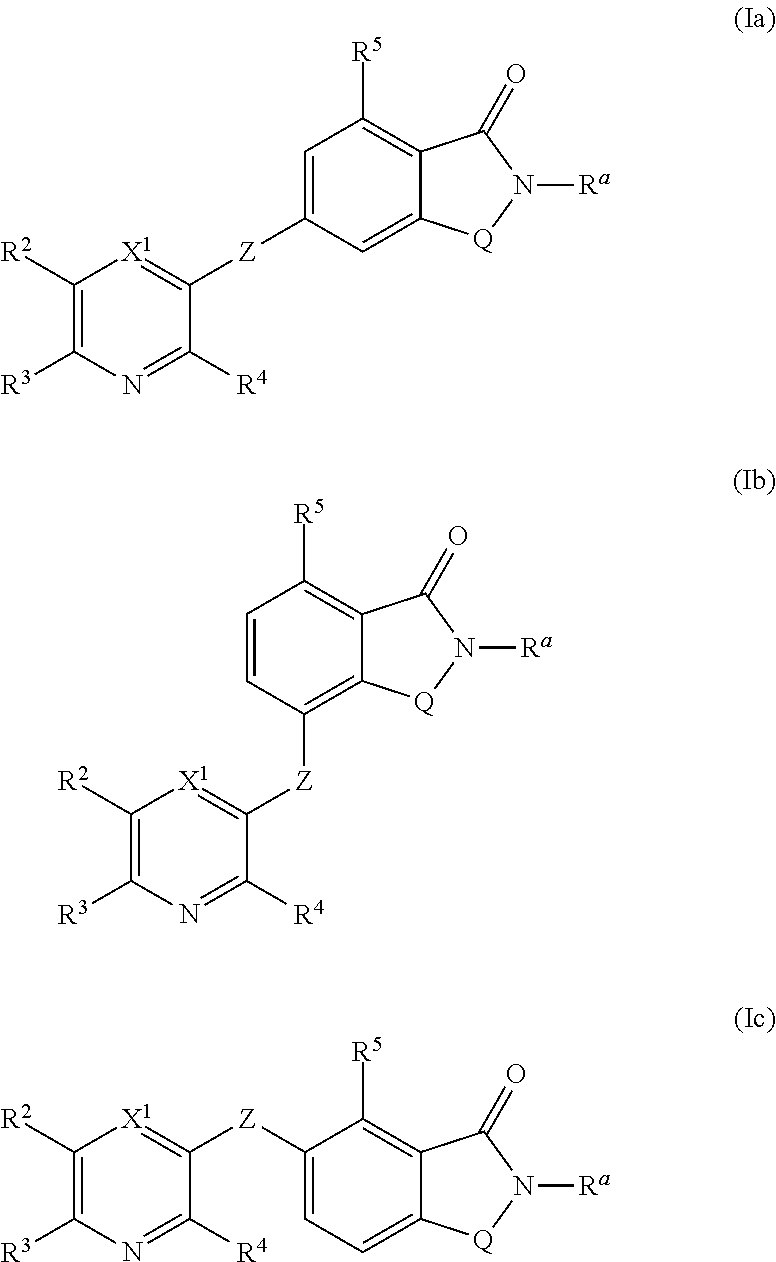Novel small molecule potentiators of metabotropic glutamate receptors
a technology of metabotropic glutamate and small molecules, which is applied in the direction of heterocyclic compound active ingredients, biocide, drug compositions, etc., can solve the problems of limiting the usefulness of such approaches, the receptor binding profile and/or the pharmacological profile is not always satisfactory, and the side effects are not always satisfied, so as to increase the response of mglu receptors, enhance the function of receptors, and increase the response of such receptors
- Summary
- Abstract
- Description
- Claims
- Application Information
AI Technical Summary
Benefits of technology
Problems solved by technology
Method used
Image
Examples
preparation examples
[0411]Abbreviations used in the Examples that follow are: Ac acetate, BINAP 2,2′-bis(diphenylphosphino)-1,1′-binaphthyl, dba dibenzylideneacetone, HPLC high performance liquid chromatography, NMP N-methylpyrrolidone.
example 1
2-butyl-5-(4-phenylpyridin-3-ylamino)isoindolin-1-one
[0412]3-Bromo-4-phenylpyridine (125 mg, 0.534 mmol) was added to a suspension of 2,2′-bis(diphenylphosphino)-1,1′-binaphthyl (BINAP) (33 mg, 0.053 mmol) and tris(dibenzylideneacetone)dipalladium(0) (Pd2(dba)3) (49 mg, 0.053 mmol) in toluene (5 mL). 5-Amino-2-butylisoindolin-1-one (120 mg, 0.587 mmol) and sodium tert-butoxide (128 mg, 1.335 mmol) were added and the mixture was stirred and heated in the microwave (120° C., 300 W, 75 min). Water and ethyl acetate were added, the organic layer was separated and the aqueous layer was extracted with ethyl acetate. The combined organic layers were washed with water and dried over MgSO4. Purification by flash chromatography (dichloromethane / methanol, gradient 1-5% methanol) provided 2-butyl-5-(4-phenylpyridin-3-ylamino)isoindolin-1-one (56 mg, 46%). ESI-MS [M+H]+=358.2.
example 2
2-butyl-5-(5-phenylpyridin-3-ylamino)isoindolin-1-one
[0413]5-Bromo-2-butylisoindolin-1-one (71.6 mg, 0.267 mmol), 5-phenylpyridin-3-amine (50.0 mg, 0.294 mmol) and Cs2CO3 (217.0 mg, 0.668 mmol) were added to suspension of 2-dicyclohexylphosphino-2′,4′,6′-triisopropylbiphenyl (X-Phos) (12.7 mg, 0.027 mmol) and palladium acetate (PdOAc2) (8.0 mg, 0.040 mmol) in toluene (2 mL). The mixture was stirred and heated in the microwave (120° C., 300 W, 60 min). Water and ethyl acetate were added. The organic layer was separated, the aqueous layer was extracted with ethyl acetate and the combined organic layers were dried over MgSO4. Purification by flash chromatography (dichloromethane / methanol, gradient 1-5% methanol) provided 2-butyl-5-(5-phenylpyridin-3-ylamino)isoindolin-1-one (53 mg, 54%). ESI-MS [M+H]+=358.1.
PUM
| Property | Measurement | Unit |
|---|---|---|
| temperatures | aaaaa | aaaaa |
| end-volume | aaaaa | aaaaa |
| chemical bond | aaaaa | aaaaa |
Abstract
Description
Claims
Application Information
 Login to View More
Login to View More - R&D
- Intellectual Property
- Life Sciences
- Materials
- Tech Scout
- Unparalleled Data Quality
- Higher Quality Content
- 60% Fewer Hallucinations
Browse by: Latest US Patents, China's latest patents, Technical Efficacy Thesaurus, Application Domain, Technology Topic, Popular Technical Reports.
© 2025 PatSnap. All rights reserved.Legal|Privacy policy|Modern Slavery Act Transparency Statement|Sitemap|About US| Contact US: help@patsnap.com



